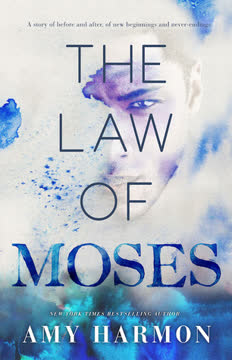Plot Summary
Baby in the Basket
Moses Wright's life begins in tragedy—left in a laundry basket by a mother lost to addiction, he's a "crack baby" the town pities but won't claim. Passed from relative to relative, Moses grows up marked by trauma, rumors, and a sense of not belonging. His story is a local legend, a cautionary tale, and a source of whispered fascination. The town's collective gaze follows him, but no one truly sees the boy inside the basket, cracked and fragile, desperate for connection. This beginning sets the tone for a life shaped by abandonment, stigma, and the longing for love—a longing that will haunt Moses and those who come to care for him.
The Cracked Boy Arrives
As Moses returns to Levan to live with his great-grandmother Kathleen, the town braces for trouble. He's nearly eighteen, beautiful and strange, with a reputation for violence, hallucinations, and compulsive painting. Georgia Shepherd, the local vet's daughter, is drawn to him despite warnings. Her family fosters troubled kids, so she recognizes the signs of a wounded soul. Moses is both alluring and dangerous, a jungle cat among sheep. Georgia's curiosity and loneliness pull her toward him, setting the stage for a collision of two restless spirits—one seeking escape, the other seeking understanding.
Horses, Healing, and Hurt
Georgia's family uses horses to heal broken children, but Moses is a different challenge. He's skittish around animals, haunted by invisible presences, and prone to zoning out. When Georgia tries to draw him into her world, a freak accident leaves her injured—her horse, usually gentle, is spooked by Moses's presence. The incident forges a strange bond between them, a mix of fear, fascination, and the first stirrings of attraction. Moses's art begins to appear—murals on barns, images that seem to come from another world. Georgia is both unsettled and enchanted, determined to uncover the secrets behind his cracked exterior.
Murals on the Barn
Moses's compulsive painting becomes his language, his way of processing the visions and memories that flood his mind. His murals are more than vandalism—they're messages, confessions, and sometimes warnings. Georgia commissions him to paint her bedroom, hoping to draw him out. As he covers her walls with a fantastical story, their connection deepens. But Moses's art is also a source of trouble, drawing suspicion and fear from the town. His paintings seem to know things no one should—faces of the dead, scenes from the past. The line between gift and curse blurs, and Georgia is pulled deeper into his world.
Rodeo Night Gone Wrong
At the county rodeo, Georgia is attacked and nearly abducted by a stranger. Moses finds her, cuts her free, and takes her home. The incident shakes the town and cements Moses's reputation as both suspect and savior. Georgia's gratitude and fascination with Moses intensify, but so do the town's suspicions. The trauma lingers, and the mystery of the attacker remains unsolved. Moses's visions grow more intense, and his art becomes darker, reflecting the violence and secrets swirling around them. Georgia's pursuit of Moses becomes relentless, even as danger circles closer.
The Girl Who Chased
Georgia refuses to be deterred by Moses's walls. She brings him lunch, teases him, and challenges his self-imposed isolation. Their banter is electric, their chemistry undeniable, but Moses resists, convinced he's too broken to be loved. Georgia's persistence pays off—she breaks through his defenses, and they share a passionate, transformative kiss. But intimacy brings new risks. Moses's visions begin to reveal more than just memories—they hint at unsolved crimes, lost girls, and a darkness lurking in the community. Georgia's love becomes both his anchor and his greatest vulnerability.
Art, Ghosts, and Secrets
Moses's art becomes a conduit for the dead. He paints faces of missing girls, scenes of violence, and memories that aren't his own. The town grows fearful, and Moses is blamed for tragedies he only witnesses in his mind. Georgia stands by him, even as his behavior grows more erratic. When his great-grandmother dies suddenly, Moses spirals—covering the house in frenzied murals, lost in a storm of grief and visions. The community turns on him, and he's institutionalized, leaving Georgia alone, heartbroken, and carrying a secret that will change both their lives.
Five Greats and Forgiveness
In the aftermath of trauma, Georgia clings to a family ritual—naming "five greats," small things to be grateful for. This practice becomes a lifeline for both her and Moses, a way to find hope amid despair. As Georgia raises their son Eli alone, she learns to forgive Moses, herself, and the world that failed them. Moses, in the psychiatric ward, begins to use his gift to help others, painting memories for grieving families. Their separation is marked by longing, regret, and the slow, painful work of healing. Forgiveness becomes the bridge that might one day bring them back together.
Love, Loss, and Laws
Years pass. Georgia's life is shaped by motherhood, grief, and the memory of Moses. Moses travels the world, using his art to connect the living and the dead, but he remains haunted by what he lost. When tragedy strikes—Eli's accidental death—both are shattered. Moses returns to Levan, drawn by visions of a little boy in Batman pajamas. Their reunion is fraught with pain, blame, and the need to confront the past. Old laws—Moses's rules for survival, Georgia's rules for self-protection—are tested and rewritten as they struggle to find a way forward.
The Color of Grief
Moses is visited by the spirit of Eli, who shows him memories, favorite things, and the small joys that made up his short life. Through these visions, Moses and Georgia begin to heal, sharing stories, art, and forgiveness. Eli's presence is both comfort and agony—a reminder of what was lost and what endures. The language of love becomes tangible: flowers, cupcakes, hearts, and the rituals of bedtime. Grief is painted in every color, and through it, Moses and Georgia rediscover each other, learning to live with loss and to love again.
The Return of Moses
Moses's return to Levan stirs old wounds and new fears. The town is on edge after another girl goes missing, and suspicion falls on Moses. As he renovates his grandmother's house and reconnects with Georgia, he's drawn into the mystery of the missing girls. His art once again becomes prophetic, revealing faces and clues that point to a killer hiding in plain sight. Georgia and Moses's renewed relationship is tested by danger, distrust, and the ghosts of the past. Together, they must confront the truth, even as it threatens to destroy them.
The Boy in Batman Pajamas
Moses is haunted by visions of Eli—a little boy in Batman pajamas—who brings him memories, warnings, and the wisdom of a child. Through Eli, Moses learns the true meaning of love, forgiveness, and letting go. Eli's presence bridges the gap between the living and the dead, guiding Moses and Georgia toward healing. The supernatural becomes a source of comfort, not fear, as Moses uses his gift to help others and to finally forgive himself. Eli's legacy is one of joy, gratitude, and the enduring power of connection.
Uncovering the Past
As Moses's visions intensify, the truth about the missing girls comes to light. The killer is someone trusted, someone hiding in plain sight. Georgia's own brush with danger is revealed to be part of a larger pattern. With the help of Moses's art and Eli's guidance, the community confronts its darkest secrets. Justice is served, but not without sacrifice. Moses is gravely wounded in the confrontation, and his fate hangs in the balance. The past is finally reckoned with, and the possibility of a new beginning emerges from the ashes of old pain.
The Killer Among Us
The revelation that the town's beloved sheriff is the killer shatters the community. Moses's confrontation with him is violent and nearly fatal. The cost of truth is high—lives are lost, innocence is destroyed, and the scars of betrayal run deep. But in the end, justice prevails, and the cycle of violence is broken. Moses's survival is uncertain, and Georgia is left to hope, pray, and bargain with the universe for one more chance at happiness. The community must learn to live with the knowledge that evil can hide behind the most trusted faces.
Death, Truth, and Redemption
Moses hovers between life and death, guided by Eli's spirit. In a luminous, otherworldly encounter, father and son share love, forgiveness, and the wisdom of letting go. Moses is given a choice—to stay or to return. He chooses life, drawn back by Georgia's love and the unfinished story they share. Their reunion is bittersweet, marked by the knowledge of all they've lost and all they still have. Together, they begin to build a new life, honoring Eli's memory and embracing the future with hope and gratitude.
Before, After, Always
In the aftermath, Moses and Georgia find peace. They marry, have a daughter, and create a family shaped by loss, love, and the lessons of the past. Moses's art continues to bridge worlds, bringing comfort to the grieving and meaning to the living. Georgia's work with horses and therapy flourishes, and together they build a life rooted in forgiveness, gratitude, and the enduring power of connection. The story ends not with an ending, but with the promise of always—before, after, and forever.
Characters
Moses Wright
Moses is the abandoned "crack baby" who grows into a man marked by trauma, genius, and a supernatural gift. His ability to see and paint the memories of the dead isolates him, making him both feared and misunderstood. Moses's psychological landscape is shaped by abandonment, stigma, and the desperate need for connection. His art is his language, his curse, and his salvation. Through love, loss, and the guidance of his son's spirit, Moses learns to forgive himself, accept his gift, and build a life rooted in gratitude and love. His journey is one of transformation—from outcast to healer, from broken boy to loving partner and father.
Georgia Shepherd
Georgia is the daughter of a vet and foster parents, raised among broken children and healing horses. Her empathy and stubbornness drive her to pursue Moses, refusing to be deterred by his walls or the town's suspicions. Georgia's psychological strength is matched by her vulnerability—her longing for love, her grief over loss, and her struggle to forgive herself. As a mother, she is devoted and self-sacrificing; as a lover, she is passionate and brave. Georgia's journey is one of resilience, learning to balance independence with intimacy, and finding hope in the face of unimaginable loss.
Eli Shepherd
Eli is the son of Moses and Georgia, a bright, joyful child whose accidental death becomes the story's emotional fulcrum. In life, he is the embodiment of love and possibility; in death, he becomes a guide, messenger, and healer. Eli's spirit visits Moses, sharing memories, wisdom, and the language of love. He teaches his parents to forgive, to cherish the small joys, and to let go. Eli's presence is both comfort and catalyst, driving the narrative toward healing and redemption.
Kathleen Wright (Gigi)
Kathleen is Moses's great-grandmother, the only family member who truly loves and accepts him. Her wisdom, patience, and unconditional support provide Moses with a sense of belonging and safety. Gigi's death is a turning point, triggering Moses's breakdown and institutionalization. Her legacy endures in the lessons she imparts—about faith, forgiveness, and the importance of letting the waters fall. Gigi is the embodiment of grace, her influence shaping Moses's journey long after she is gone.
Tag (David Taggert)
Tag is a Texan with his own scars—his sister Molly was one of the missing girls, and his struggles with addiction and guilt mirror Moses's own battles. Tag becomes Moses's unlikely friend and traveling companion, helping him harness his gift and find purpose. Their friendship is a lifeline for both, offering humor, support, and a sense of family. Tag's journey is one of redemption, learning to forgive himself and to fight for life, even when it hurts.
Sheriff Jacob Dawson
Sheriff Dawson is the town's trusted lawman, a figure of authority and stability. Beneath the surface, he is the story's true villain—a serial killer preying on vulnerable girls. His psychological complexity lies in his ability to compartmentalize, to present a façade of decency while committing unspeakable acts. Dawson's betrayal shatters the community and forces a reckoning with the darkness that can hide behind the most trusted faces.
Georgia's Parents (Martin and Mauna Shepherd)
Georgia's parents are pillars of the community, dedicated to healing others through their work with horses and foster children. Their love for Georgia is fierce, but their own grief and guilt over Eli's death strain their relationship. Martin's anger and Mauna's anxiety reflect the ways trauma ripples through families. Their journey is one of learning to let go, to forgive, and to support Georgia as she forges her own path.
Molly Taggert
Molly is one of the missing girls whose spirit haunts Moses's art and Tag's memories. Her disappearance and death are central to the mystery that drives the narrative. Molly's presence is felt through visions, memories, and the pain of those who loved her. She represents the countless lost and forgotten, her story a call for justice and remembrance.
Lisa Kendrick
Lisa is a local girl whose abduction by Sheriff Dawson brings the truth to light. Her connection to Moses—through her cousin Sylvie, another victim—triggers the final confrontation. Lisa's survival is a testament to resilience and the power of community to protect its own.
Sylvie Kendrick
Sylvie is another of Dawson's victims, her face appearing in Moses's art and haunting the walls of the old mill. Her story, like Molly's, is one of loss and injustice. Through Moses's gift, Sylvie and the other girls are finally seen, their stories told, and their memories honored.
Plot Devices
Art as Medium and Message
Moses's compulsive art is the central device of the novel, serving as both a literal and metaphorical bridge between worlds. His paintings reveal secrets, solve mysteries, and give voice to the dead. Art becomes a language for trauma, love, and healing—a way to process the unprocessable and to connect with others across the boundaries of life and death. The murals, portraits, and still lifes are not just background—they are active agents in the plot, driving the narrative forward and deepening the emotional resonance.
Supernatural Visions and Ghosts
Moses's ability to see and communicate with the dead is both a gift and a curse. These visions are not just plot twists—they are windows into the psychological and emotional truths of the characters. The ghosts are not malevolent; they are lost, longing, and in need of closure. Through them, the story explores themes of grief, memory, and the persistence of love beyond death. The supernatural is woven seamlessly into the fabric of the narrative, blurring the line between reality and imagination.
Dual Narration and Shifting Perspectives
The novel alternates between Moses's and Georgia's points of view, allowing readers to experience the story from both inside and outside the trauma. This dual narration deepens the emotional impact, revealing the misunderstandings, secrets, and desires that drive the characters apart and bring them back together. The shifting perspectives also allow for dramatic irony, as readers know more than the characters at key moments, heightening tension and empathy.
Foreshadowing and Nonlinear Structure
The story is structured around the idea of "before" and "after"—the pivotal moments that divide lives into what came before and what comes after. Foreshadowing is used to build suspense, with early hints of tragedy, loss, and the supernatural. The nonlinear unfolding of events mirrors the way trauma is experienced—fragmented, cyclical, and always present. The past is never truly past; it shapes every choice and every relationship.
The Five Greats
The ritual of naming "five greats"—small things to be grateful for—is a recurring motif that grounds the characters in the present and offers a path through pain. This device is both practical and symbolic, representing the power of gratitude to transform suffering and to create connection. It becomes a language of love, a way to honor the dead, and a tool for forgiveness.
Analysis
The Law of Moses is a novel that refuses easy answers or tidy resolutions. It is, at its core, a story about the ways we are broken—by loss, by violence, by the failures of those meant to protect us—and the ways we find meaning and connection in the aftermath. Through the intertwined journeys of Moses and Georgia, the book explores the limits of forgiveness, the necessity of gratitude, and the redemptive power of love. The supernatural elements are not escapist; they are metaphors for the ways the past haunts the present, and for the possibility of healing through art, ritual, and relationship. The novel challenges readers to confront uncomfortable truths: that evil can hide in plain sight, that grief never truly ends, and that love is both risk and reward. Ultimately, The Law of Moses is a testament to resilience—the ability to find beauty in brokenness, to rewrite the laws that govern our lives, and to choose hope, even when hope seems impossible.
Last updated:
Review Summary
The Law of Moses received mostly positive reviews, with readers praising Amy Harmon's beautiful writing and emotional storytelling. Many found the book deeply moving and thought-provoking, appreciating its themes of love, loss, and forgiveness. The unique plot and well-developed characters were frequently mentioned. Some readers were surprised by the paranormal elements and wished they had known about them beforehand. A few critics felt the connection between the main characters was lacking or disliked certain plot devices. Overall, most readers found it to be a powerful and unforgettable story.







